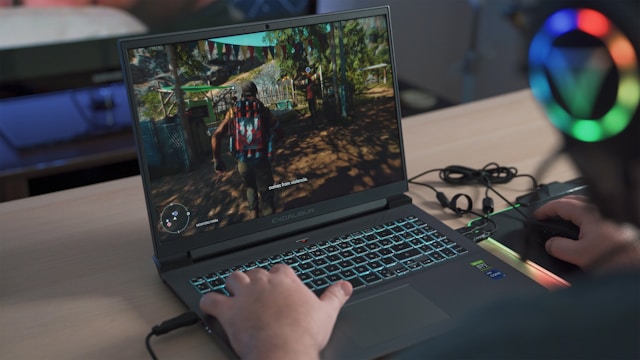In modern gaming, two technologies quietly shape the pace and experience of every session: RNG and frame-upgrading systems. These tools influence everything from enemy behavior and loot drops to visual fluidity and player immersion. Whether subtle or overt, their impact defines how smooth, unpredictable, and satisfying a game feels.
RNG, or random number generation, is often misunderstood. Far from chaotic, it follows precise rules to keep gameplay engaging and dynamic. Frame-upgrading systems, meanwhile, are responsible for refining visuals in real-time. They deliver crisp animations and reduce stutter, especially during fast-paced sequences. Together, these systems enhance game quality at both mechanical and aesthetic levels.
Gameplay Variety Through RNG Mechanics
RNG introduces variability, which helps games avoid repetitive loops. It ensures each encounter feels fresh without requiring new content.
Loot Systems Benefit from Controlled Randomness
Item generation systems rely heavily on RNG to determine rewards. A drop table might include rare weapons, consumables, or cosmetics. Rather than handing out items in a fixed order, the game uses RNG to decide outcomes. This randomness boosts engagement by creating anticipation. Themed experiences like Huff N More Puff, a casino slot game, for example, use similar mechanics to keep outcomes unpredictable while still feeling rewarding. Players return not just to progress but to see what they might get next.
The best implementations balance randomness with fairness. Guaranteed drops after multiple attempts or tiered probability systems keep frustration low. RNG makes each loot box or treasure chest meaningful while still offering long-term replay value.
Enemy Patterns Become Less Predictable
In combat-based games, predictable enemies can break immersion. RNG allows developers to script slight variations in enemy behavior, movement, or attack timing. For example, a boss might choose one of three attack combos based on a randomized input. The player remains on edge, driven by unpredictability and the constant possibility of surprise.
RNG-driven patterns make single-player titles feel less scripted. Multiplayer shooters and action games also rely on these systems to alter spawn points, item locations, or round sequences. The result is a more organic, less repetitive experience.
Frame-Upgrading Sharpens Visual Feedback
Frame-upgrading systems support the visual performance of modern games. They work alongside graphics processors to ensure frames are displayed as smoothly as possible.
Interpolation and Smoothing Elevate Animation
A core function of frame-upgrading systems is interpolation. This means generating in-between frames when the source frame rate is low or unstable. Instead of displaying 30 jagged frames per second, the system fills in missing visual data to simulate 60 or more. The game appears more fluid even when hardware resources are limited.
This is especially important in racing games, fast brawlers, and high-motion scenes. With improved motion clarity, player response time sharpens. Split-second decisions become easier because the eye perceives more continuity.
Reducing Visual Lag Improves Control
Visual lag can occur when frame output does not match input timing. If a button press results in a delayed response onscreen, players lose trust in the game’s responsiveness. Frame-upgrading tools minimize this lag by reducing dropped or delayed frames. This synchronizes inputs with on-screen results, creating a tighter feedback loop.
Players may not always notice this system working, but they will feel the difference. Movement becomes more accurate. Animations flow more naturally. Reaction-based gameplay benefits significantly from this improvement.
Seamless Integration Improves Replay Quality
When both RNG and frame-upgrading work together, gameplay becomes more enjoyable, consistent, and dynamic. Their integration supports both casual and competitive play.
Randomness Creates Infinite Scenarios
Games with strong RNG systems rarely feel static. Whether exploring dungeons or playing card-based rounds, the variability ensures no two sessions are identical. This unpredictability makes even short playthroughs worth repeating. New players feel welcomed by forgiving probabilities, while seasoned players chase rare outcomes.
Replay loops thrive on these mechanics. The quest for a high score, a rare item, or a speedrun time feels fresh each time. Developers can extend the life of their games without constant content updates.
Frame Quality Preserves Flow in High-Intensity Matches
Lag spikes, skipped frames, or jittery camera movements can ruin a close match. Frame-upgrading systems keep the action fluid under pressure. This is critical in esports titles and any game where milliseconds matter.
By smoothing performance across all hardware, developers widen access. A player with mid-tier specs can still enjoy responsive controls and clear visuals. This levels the field without compromising fidelity.
Design Strategy Behind These Enhancements
Developers use both RNG and frame-upgrading intentionally. These systems are not patches for poor design. They are part of a broader strategy to create long-term engagement.
Controlled Randomness Adds Depth Without Overload
Smart RNG design involves setting upper and lower limits, then applying modifiers. A weapon might have a 5 percent chance to deal bonus damage, but only under certain conditions. These hidden layers give skilled players more to uncover without overwhelming casual users.
This careful balancing also prevents frustration by ensuring gameplay remains engaging without feeling unfair. A well-tuned mix of skill and randomness keeps players invested and coming back. Developers build guardrails like pity timers, stat thresholds, or bonus rolls to keep outcomes within an enjoyable range.
Performance Tools Extend Platform Compatibility
As games grow in size and complexity, frame-upgrading keeps them accessible. Titles optimized with these tools can run across a wider range of hardware, including lower-end PCs or handhelds. By interpolating visuals and regulating pacing, games feel responsive even without top-tier specs.
This is crucial in reaching more players globally. Instead of lowering graphics settings or compromising gameplay, developers use frame-upgrading to maintain quality across diverse systems.
The Impact on Modern Player Expectations
Today’s players are more aware of performance and fairness. These systems help games meet those expectations.
Random elements increase excitement while structured odds prevent burnout. Fluid visuals ensure players stay connected to the action. These technologies are no longer invisible. They are part of what makes a game feel satisfying, stable, and rewarding across multiple sessions.
Modern players notice when something feels off. A game that drops frames or feels repetitive will not last long. These enhancement systems create consistency behind the scenes, so the player experience remains sharp.
Sharper Design Leads to Deeper Immersion
The success of a modern game often comes down to small things working well together. RNG and frame-upgrading systems are two of those elements. They shape how players move, react, and engage without ever stepping into the spotlight.
Their value lies in how they quietly elevate the whole experience. What once felt clunky becomes smooth. What once felt stale now feels dynamic. These tools are not flashy features. They are the foundation that supports great gameplay across genres.



